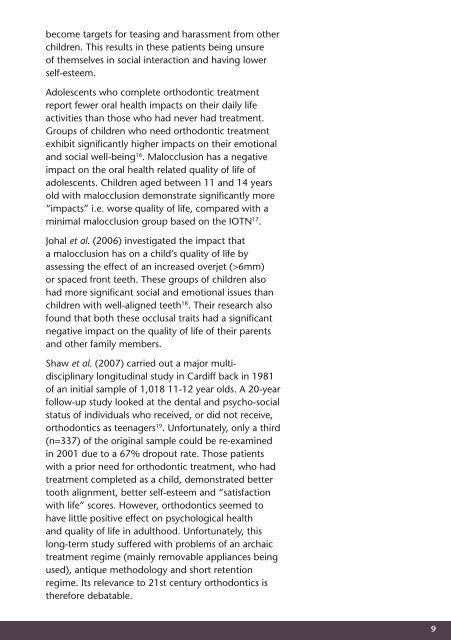Justification%20for%20orthodontic%20treatment
Justification%20for%20orthodontic%20treatment
Justification%20for%20orthodontic%20treatment
You also want an ePaper? Increase the reach of your titles
YUMPU automatically turns print PDFs into web optimized ePapers that Google loves.
ecome targets for teasing and harassment from other<br />
children. This results in these patients being unsure<br />
of themselves in social interaction and having lower<br />
self-esteem.<br />
Adolescents who complete orthodontic treatment<br />
report fewer oral health impacts on their daily life<br />
activities than those who had never had treatment.<br />
Groups of children who need orthodontic treatment<br />
exhibit significantly higher impacts on their emotional<br />
and social well-being 16 . Malocclusion has a negative<br />
impact on the oral health related quality of life of<br />
adolescents. Children aged between 11 and 14 years<br />
old with malocclusion demonstrate significantly more<br />
“impacts” i.e. worse quality of life, compared with a<br />
minimal malocclusion group based on the IOTN 17 .<br />
Johal et al. (2006) investigated the impact that<br />
a malocclusion has on a child’s quality of life by<br />
assessing the effect of an increased overjet (>6mm)<br />
or spaced front teeth. These groups of children also<br />
had more significant social and emotional issues than<br />
children with well-aligned teeth 18 . Their research also<br />
found that both these occlusal traits had a significant<br />
negative impact on the quality of life of their parents<br />
and other family members.<br />
Shaw et al. (2007) carried out a major multidisciplinary<br />
longitudinal study in Cardiff back in 1981<br />
of an initial sample of 1,018 11-12 year olds. A 20-year<br />
follow-up study looked at the dental and psycho-social<br />
status of individuals who received, or did not receive,<br />
orthodontics as teenagers 19 . Unfortunately, only a third<br />
(n=337) of the original sample could be re-examined<br />
in 2001 due to a 67% dropout rate. Those patients<br />
with a prior need for orthodontic treatment, who had<br />
treatment completed as a child, demonstrated better<br />
tooth alignment, better self-esteem and “satisfaction<br />
with life” scores. However, orthodontics seemed to<br />
have little positive effect on psychological health<br />
and quality of life in adulthood. Unfortunately, this<br />
long-term study suffered with problems of an archaic<br />
treatment regime (mainly removable appliances being<br />
used), antique methodology and short retention<br />
regime. Its relevance to 21st century orthodontics is<br />
therefore debatable.<br />
9


